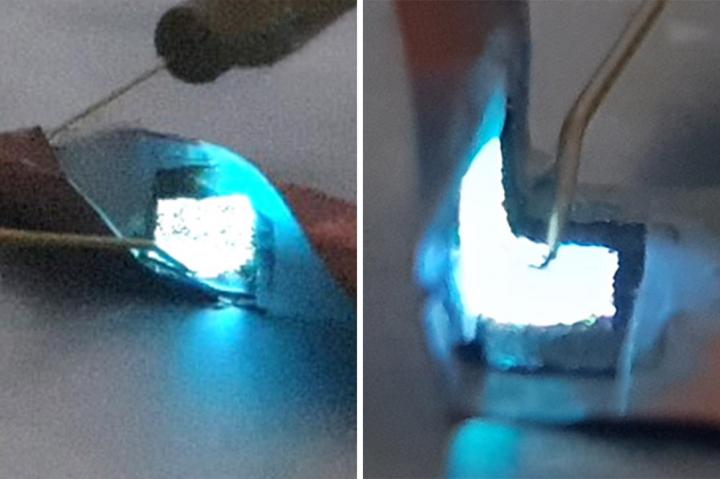Team’s flexible micro LEDs may reshape future of wearable technology

The flexible micro LEDs can be twisted (on left) or folded (on the right). The LEDs, which can be peeled off and stuck to almost any surface, could help pave the way for the next generation of wearable technology.
Credit: The University of Texas at Dallas
Novel devices can be folded, cut, attached to surfaces
University of Texas at Dallas researchers and their international colleagues have developed a method to create micro LEDs that can be folded, twisted, cut and stuck to different surfaces.
The research, published online in June in the journal Science Advances, helps pave the way for the next generation of flexible, wearable technology.
Used in products ranging from brake lights to billboards, LEDs are ideal components for backlighting and displays in electronic devices because they are lightweight, thin, energy efficient and visible in different types of lighting. Micro LEDs, which can be as small as 2 micrometers and bundled to be any size, provide higher resolution than other LEDs. Their size makes them a good fit for small devices such as smart watches, but they can be bundled to work in flat-screen TVs and other larger displays. LEDs of all sizes, however, are brittle and typically can only be used on flat surfaces.
The researchers’ new micro LEDs aim to fill a demand for bendable, wearable electronics.
“The biggest benefit of this research is that we have created a detachable LED that can be attached to almost anything,” said Dr. Moon Kim, Louis Beecherl Jr. Distinguished Professor of materials science and engineering at UT Dallas and a corresponding author of the study. “You can transfer it onto your clothing or even rubber — that was the main idea. It can survive even if you wrinkle it. If you cut it, you can use half of the LED.”
Researchers in the Erik Jonsson School of Engineering and Computer Science and the School of Natural Sciences and Mathematics helped develop the flexible LED through a technique called remote epitaxy, which involves growing a thin layer of LED crystals on the surface of a sapphire crystal wafer, or substrate.
Typically, the LED would remain on the wafer. To make it detachable, researchers added a nonstick layer to the substrate, which acts similarly to the way parchment paper protects a baking sheet and allows for the easy removal of cookies, for instance. The added layer, made of a one-atom-thick sheet of carbon called graphene, prevents the new layer of LED crystals from sticking to the wafer.
“The graphene does not form chemical bonds with the LED material, so it adds a layer that allows us to peel the LEDs from the wafer and stick them to any surface,” said Kim, who oversaw the physical analysis of the LEDs using an atomic resolution scanning/transmission electron microscope at UT Dallas’ Nano Characterization Facility.
Colleagues in South Korea carried out laboratory tests of LEDs by adhering them to curved surfaces, as well as to materials that were subsequently twisted, bent and crumpled. In another demonstration, they adhered an LED to the legs of a Lego minifigure with different leg positions.
Bending and cutting do not affect the quality or electronic properties of the LED, Kim said.
The bendy LEDs have a variety of possible uses, including flexible lighting, clothing and wearable biomedical devices. From a manufacturing perspective, the fabrication technique offers another advantage: Because the LED can be removed without breaking the underlying wafer substrate, the wafer can be used repeatedly.
“You can use one substrate many times, and it will have the same functionality,” Kim said.
In ongoing studies, the researchers also are applying the fabrication technique to other types of materials.
“It’s very exciting; this method is not limited to one type of material,” Kim said. “It’s open to all kinds of materials.”
###
Other UT Dallas researchers involved in the study included Dr. Anvar Zakhidov, professor of physics; and Qingxiao Wang and Sunah Kwon, doctoral students and research assistants in materials science and engineering.
Other authors of the study were affiliated with Los Alamos National Laboratory, as well as organizations in South Korea, including Sejong University, Ewha Womans University, Korea Electronics Technology Institute, CoAsia Corp., Pohang University of Science and Technology, and Korea University. The research was funded in part by the National Research Foundation of Korea, the Korea Institute for Advanced Technology and the U.S. Department of Energy.
Media Contact
All latest news from the category: Materials Sciences
Materials management deals with the research, development, manufacturing and processing of raw and industrial materials. Key aspects here are biological and medical issues, which play an increasingly important role in this field.
innovations-report offers in-depth articles related to the development and application of materials and the structure and properties of new materials.
Newest articles
Faster, more energy-efficient way to manufacture an industrially important chemical
Zirconium combined with silicon nitride enhances the conversion of propane — present in natural gas — needed to create in-demand plastic, polypropylene. Polypropylene is a common type of plastic found…

Energy planning in Ghana as a role model for the world
Improving the resilience of energy systems in the Global South. What criteria should we use to better plan for resilient energy systems? How do socio-economic, technical and climate change related…

Artificial blood vessels could improve heart bypass outcomes
Artificial blood vessels could improve heart bypass outcomes. 3D-printed blood vessels, which closely mimic the properties of human veins, could transform the treatment of cardiovascular diseases. Strong, flexible, gel-like tubes…





















